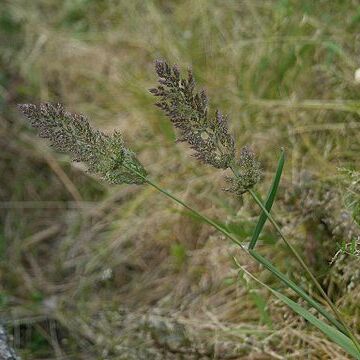Loosely tufted annuals, very variable in size, 4-70-(90) cm. Leaf-sheath ± loose, chartaceous, striate, usually finely scabrid above. Ligule (1.5)-4-9 mm, oblong, rounded, lacerate, abaxially finely scabrid. Leaf-blade (1)-6-15 cm × (1.5)-3-4.5-(8) mm, flat, minutely scabrid throughout or sometimes only on ribs near tip and on margins. Culm (3)-10-60 cm, ± erect, or ascending from geniculate base, internodes glabrous. Panicle 1-6 × 0.5-4-(7) cm, dense, cylindric to ovate-lanceolate, often lobed to ± interrupted at base; rachis smooth to scabrid above, with fascicled, finely scabrid branches and short, finely scabrid pedicels disarticulating near base. Spikelets 3-5 mm, oblong, light green, sometimes purplish, falling entire at maturity with most of pedicel attached. Glumes equalling spikelet, ± evenly scabrid, margins usually sparsely ciliate in lower ½, narrowed to shallowly notched apex with very fine, straight, terminal scabrid awn 1.5-2.5-(3) mm. Lemma 1-1.4 mm, hyaline, glabrous, elliptic-oblong, denticulate-truncate or minutely 4-toothed, usually with a fine, caducous apical awn (1.4-2.6 mm). Palea slightly shorter and narrower than lemma, keels ± excurrent. Anthers 0.5-0.7 mm. Caryopsis 0.9-1.2 × 0.4-0.5 mm.
More
Annual, tufted. Culms geniculate, sometimes trailing and rooting at lower nodes, 10–75 cm tall. Leaf blades linear or broadly linear, 2.5–15 cm, 3–10 mm wide, scabrid or adaxial surface smooth, apex acute; ligule 3–8 mm. Panicle densely cylindrical, slightly lobed, or looser and narrowly ovate, 4–15 cm, pale green or flushed purple; branches narrowly ascending, up to 4 cm, bearing densely clustered spikelets. Spikelets narrowly oblong, 2–2.5 mm; glumes narrowly oblong, puberulous, vein scabrid-aculeate, margins shortly ciliate in lower half, apex emarginate, awned from sinus; awn shorter than or up to 1.5 times as long as glume body; lemma elliptic, 1–1.2 mm, apex slightly 4-toothed, midvein extended into a fine, straight, ca. 2 mm awn; palea as long as lemma. Stamens 3, anthers ca. 0.7 mm. Caryopsis elliptic, ca. 1 mm. Fl. and fr. Apr–Sep.

